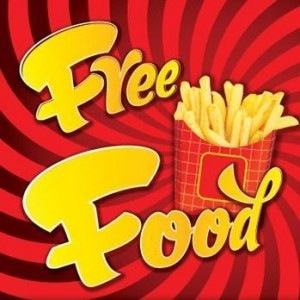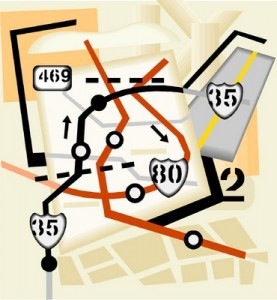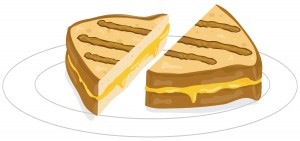 Morning meeting. Right in front of you: platter loaded with bagels, danish, and doughnuts parked next to giant coffee urns. A freebie breakfast and the beginning of a blood sugar roller coaster ride.
Morning meeting. Right in front of you: platter loaded with bagels, danish, and doughnuts parked next to giant coffee urns. A freebie breakfast and the beginning of a blood sugar roller coaster ride.
No worries if you miss the morning carb fest – if all the platters aren’t picked clean the remnants will surely end up in the snack room next to the birthday cake (it’s always somebody’s birthday) or the leftover cookies from someone’s party the night before.
Costco on the weekend. There are at least three tables manned by people offering you samples of hot pizza, luscious cheesecake, or tooth-picked pigs ‘n blankets. Just the right size to quickly and neatly pop into your mouth – especially when you circle back for seconds.
Errands. Stops at the cleaners, the tailors, the veterinarian, the hair salon. On the desk or counter: giant bowls piled high with freebie candy. You can dig deep for the kind you like – Reese’s Peanut Butter Cups, mini Snickers, Tootsie Roll pops. You name it — it’s usually there for the taking.
Party or wedding. How do you escape the platters of salami, cheese, mini quiches, and then the desserts covered with icing, whipped cream, and powdered sugar?
What’s The Problem With Free Food?
Not a thing if you don’t care about calories, nutrition, and how you’ll feel after an overload of sugar, fat, and salt. Tons of “starving” students and young (and not so young) adults have chowed down on ample quantities of free food. Here’s the question: are full bellies with no impact on the wallet ultimately the best choice?
Occasional dips into free food are probably not going to hurt anyone in reasonable health. But, on a consistent basis, there is certainly a downside to your health. There could me a more immediate concern, too. A whole bunch of non-nutritious (junk, processed, and high calorie) food eaten right before a time when intense concentration and focus is necessary (translation: exams and presentations) could certainly have a negative impact.
Why Do We Find Free Food So Attractive?
Most of us find it pretty darn hard to ignore “free food,” the food that’s just there for the taking. It’s everywhere – and we’ve become accustomed to valuing cheap calories. Think about it: when was the last time you resisted the peanuts, pretzels, or popcorn sitting on the bar counter? What about the breadbasket – that’s usually free, too.
We don’t have to eat any of this stuff. But we do. Why? Some of us have trouble passing up a giveaway regardless of what it is. Some see it as a way to save money – despite possible negative health consequences. And a lot of us use “free” as an excuse or sanction to eat or overeat sweet, salty, fatty junk food.
And the calories? Free doesn’t mean calorie free. But it’s all too easy to forget about those calories you popped in your mouth as you snagged candy here and tasted a cookie there. Yikes. You could eat a day’s worth of calories cruising through a couple of markets and food stores.
Before The Freebies Land In Your Mouth
How about creating your own mental checklist that, with practice, can help you figure out whether or not it’s worth it to indulge. Even f you decide to go for it and taste the salami, butter cookies, and cheese cake, at least you’ll have made a mindful decision rather than mindlessly shoving food in your mouth.
Ask yourself: Is the food you’re so willing to pop in your mouth . . .
- fresh and tasty, with some nutrition? It might be if you’re at a wedding or an event, but the odds go down if it’s food handed out at the supermarket or grabbed out of a large bowl at the cleaners.
- clean? How many fingers have been in the bowl of peanuts or have grabbed pieces of cheese or cookies off of an open platter?
- something you really want – or are you eating it just because it’s there?
- loaded with fat, sugar, and salt that adds up to mega calories? Every calorie counts whether it’s popped in your mouth and gone in the blink of an eye or savored more slowly and eaten with utensils off of a plate.
Choices, Choices
Just because food is free doesn’t mean you have to eat it. No one is forcing you. Beware of the cascading effect: if you let yourself sample the candy, pizza, cheesecake, popcorn, or cookies, perhaps you’re giving yourself permission to continue to overindulge in food you probably don’t want to/shouldn’t be eating.
Highly caloric, sugary, and fatty foods can act as the key to opening the flood gates that cause you to continue to indulge for the rest of the day (weekend/week). Loading up on simple sugars – the kind found in candy, cookies, cake, and many processed foods – causes your blood sugar level to spike and then to drop –leaving you hungry very quickly and pretty darn cranky — and isn’t great for your waistline, either.


